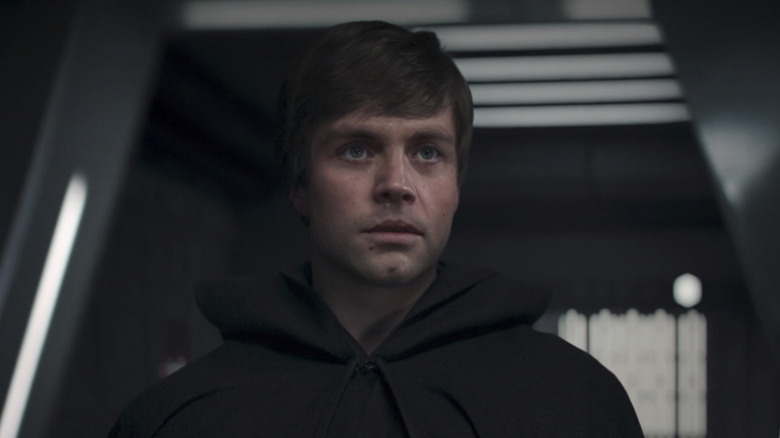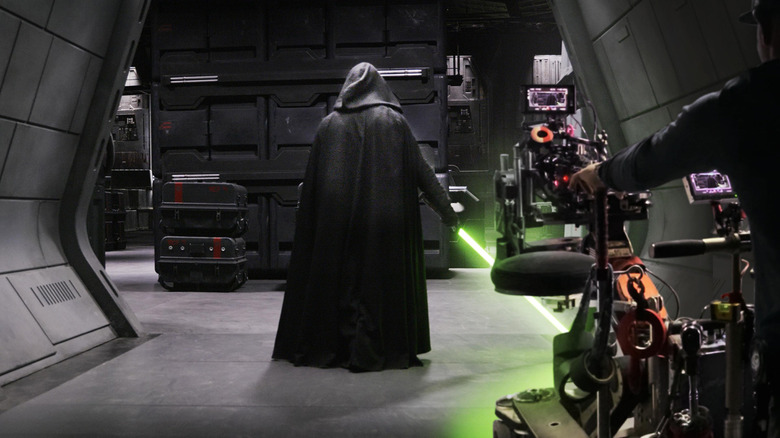Here's How The Mandalorian Replicated Mark Hamill's Voice For Luke Skywalker's Return
Testing the limits of new technology is as ingrained in the DNA of "Star Wars" as lightsabers, fashionable bathrobes, and the hero's journey itself. Both the Original and Prequel trilogies pioneered new advances in special effects that laid the groundwork for the next generation of blockbusters that followed in their footsteps. "The Mandalorian" was the latest "Star Wars" production to attempt to live up to that established history of innovation by de-aging Mark Hamill for a surprise appearance in the season 2 finale ... but not everything was as it seemed. As it turns out, what we thought we were hearing wasn't actually Hamill's voice after all. It was yet another layer of technology-assisted magic.
Skywalker "Speaks"
"Disney Gallery: The Mandalorian" is a new behind-the-scenes special giving fans a fresh look at everything that went into creating the shocking and much-discussed return of a de-aged Mark Hamill as Luke Skywalker. It seemed obvious enough that some digital trickery was going on to fool our eyes into thinking that a post-"Return of the Jedi" Hamill suddenly stepped through a time machine and back onto our screens, but what few fans realized until now is that our ears were deceiving us, as well. A new episode revealed (via Heroic Hollywood) that Luke's voice was completely synthesized, using fancy new tech to recreate the authentic-sounding voice of a young Mark Hamill. Creator Jon Favreau drops the bombshell himself:
"Something people didn't realize is that his voice isn't real. His voice, the young Luke Skywalker voice, is completely synthesized using an application called Respeecher."
Matthew Wood, a sound editor working on Star Wars since the special editions of the Original Trilogy and who also worked on "The Mandalorian," goes into even further detail on the advanced program that they used.
"It's a neural network you feed information into and it learns. So I had archival material from Mark in that era. We had clean recorded ADR from the original films, a book on tape he'd done from those eras, and then also Star Wars radio plays he had done back in that time. I was able to get clean recordings of that, feed it into the system, and they were able to slice it up and feed their neural network to learn this data."
It stood to reason that some amount of post-production fiddling was going on to bring back Hamill's voice from his currently deeper and more gravelly timbre to the pitch that's forever immortalized in the Original Trilogy, but it's quite surprising to find out that the creative team didn't even need to use any new Hamill dialogue whatsoever to achieve the effect.
I've gone on record saying that while the special effects for this new era of "Star Wars" media has been consistently spectacular, Lucasfilm has also suffered some pretty major tech-related bumps along the way. Digitally recreating the late Peter Cushing's Grand Moff Tarkin as well as Carrie Fisher's Princess Leia for cameos in "Rogue One: A Star Wars Story" inspired widespread backlash ranging from "poor taste" to "nightmare fuel." Attempting to cobble together a performance from leftover deleted scenes and at least one notable instance of CGI for the late Fisher in "The Rise of Skywalker" also proved to be wildly misguided, especially considering the fact that Lucasfilm initially promised never to do the latter. Personally, I couldn't believe my eyes when I saw young Luke come out of nowhere to appear in "The Mandalorian" — partly out of shock, of course, but mostly because the illusion simply wasn't even close to being convincing enough.
Lucasfilm seems to have recognized this, hiring the viral deeptfake YouTuber for what will almost assuredly be even more implementations of the tech down the line. This trend makes me feel more than a little uncomfortable, but it's also showing no signs of stopping anytime soon.

